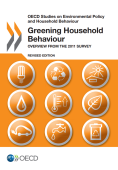This publication proposes a conceptual framework for the characterisation of green jobs in Malaysia and the selection of technical indicators in the environmental and labour fields to be used for this process. The report brings an initial estimation of direct green jobs at the country level as well as a review of the decent work challenges that may be linked to green jobs. The report provides information and statistical data to assess the economic and employment impacts of a green development strategy and provides information on the sectors which promote environmentally-friendly decent work. It includes policy recommendations for the government and social partners to identify entry points for further green job creation.
This publication examines the linkages between the environment and the economy and the implications for the labour market of climate change. The report evaluates the linkages between economic, social and environmental policies in the Philippines. It provides qualitative and quantitative information on the number and types of green jobs in key sectors of the economy, estimating actual green jobs in existing industries, based on available published data and substantiated by consultations and actual surveys.
The mapping study was conducted to estimate and identify green jobs in the Philippines. It has identified potential challenges to developing a greener economy with green jobs and decent work. The report provides information and statistical data to assess the economic and employment impacts of a green development strategy and provides information on the sectors which promote environmentally-friendly decent work (green jobs). It includes policy recommendations for the government and social partners to identify entry points for further green job creation.
As emissions trading schemes (ETS) continue to emerge around the world, governments are starting to consider and implement linkages between their domestic schemes. This paper analyses the case for a link between the EU ETS and the upcoming South Korean ETS. The authors assess key features of the planned South Korean ETS to determine elements that have the potential to facilitate or prevent linkage. The paper draws on lessons from previous linkage examples and makes concrete policy recommendations for the South Korean case. The linkage debate is placed in the larger context of international cooperation on climate change.

Developing growth strategies that promote greener lifestyles requires a good understanding of what factors affect people’s behaviour towards the environment. Recent OECD work based on periodic surveys of more than 10, 000 households across a number of countries and areas represents a breakthrough by providing a common framework to collect unique empirical evidence for better policy design.
This publication presents responses from the most recent round of the OECD survey implemented in 2011 in 5 areas (energy, food, transport, waste and water) and 11 countries: Australia, Canada, Chile, France, Israel, Japan, Korea, the Netherlands, Spain, Sweden and Switzerland.
Analysis comparing the data across countries, policy conditions and households’ characteristics reveals which measures most effectively change behaviour. Each round of the survey also allows to track changes over time and to explore new emerging issues.
The objective of this study is to assess whether the financing practice of recovery efforts is consistent with the international architecture in place to promote the transition from crisis to sustainable development in fragile and conflict-affected states. The recommendations of this study are based on a mapping and comparative analysis of humanitarian, development and climate adaptation pooled financing mechanisms at the global and country levels. Findings from this study reveal that the current financing practice reinforces rather than bridges a silo approach towards recovery efforts. Development pooled financing mechanisms for recovery in fragile and conflict-affected countries are limited in terms of their: i) coverage - they do not exist in the majority of countries or are established too late to promote synergies with humanitarian assistance; ii) capitalization - they are too small and fragmented to act as gravity centres for aid coordination and alignment; and iii) coherence - they cover too many issues, leaving some key areas unaddressed.
